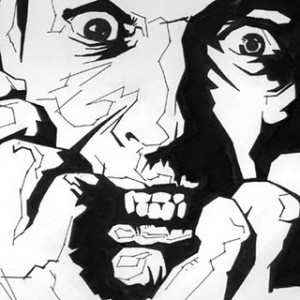Una de las ideas proyecto de articulo que tengo de vez en cuando es un estudio del miedo. Stephen King señala que es físicamente la más debilitante de las emociones humanas. Los bombeos de sangre, los poros chorrean, los aumentos de ritmo cardíaco. El miedo es la raíz de todo mal. Toda la tristeza se basa en el miedo. La condición bajo la que trabajo se basa en el miedo.
El ataque de pánico es la manifestación física más grande de miedo. Usted obtiene los síntomas que he enumerado anteriormente, además de sus extremidades hormigueo y entumecimiento, se obtiene un mareo en la cabeza, un temblor en las piernas. La única cosa que no sucede a mí es lo estereotipado de orinar o ensuciar a ti mismo, por lo que supongo que le estoy agradecido.
Sin embargo, los aspectos físicos no son la mitad de ella. Los ataques generalmente ocurren fuera, cuando hay cargas pasando – tiendas, grandes logos, el tráfico pesado, caminos de ancho, un montón de gente alrededor. La mente se rebela: es sobrecargada, es decir demasiada información. Y luego está este desrealización repugnante, y eso es la parte más aterradora: que está convencido de que nada de esto es realmente verdadero, y que el universo está a punto de veces sobre sí misma. De repente, nada tiene sentido. Frases sin sentido de la conversación a su alrededor y fragmentos de canciones pasan por la cabeza. Uno siente que han caído en el borde del mundo.
El ataque de pánico es como un rechazo del mundo tal como es. Sartre describe este rechazo como “náuseas ‘; Soren Kierkegaard llamó” temor y temblor », mientras que Hunter S Thompson apodado” el miedo y el odio “. ¿Crees que el Duque de escalonamiento por Las Vegas, que van y vienen de una botella de Ethel y pensar que esto es lo que el mundo hubiera sido como si los nazis hubieran ganado la guerra. Los escritores tienen la costumbre de ver el mundo de maneras extrañas. Si hay un vínculo entre la literatura y el pánico, o la creatividad y la enfermedad mental en general, sin duda se encuentra aquí.
One of the book project ideas that I get from time to time is a study of fear. Stephen King notes that it is the most physically debilitating of human emotions. The blood pounds, the pores gush, the heartrate increases. Fear is the root of everything bad. All sadness is based on fear. The Condition I labour under is based on fear.
The panic attack is the greatest physical manifestation of fear. You get the symptoms I’ve listed above, plus your limbs go tingly and numb, you get a dizziness in your head, a shakiness in your legs. The only thing that doesn’t happen to me is the cliched thing of pissing or soiling yourself, for which I suppose I’m grateful.
But the physical aspects aren’t the half of it. Attacks generally happen outside, when there’s loads going on – shops, big logos, heavy traffic, wide roads, loads of people around. The mind is rebelling: it’s overloaded, it’s saying too much information. And then there’s this sickening derealisation, and that’s the most terrifying part: you’re convinced that none of this is actually real, and that the universe is about to fold in on itself. Suddenly nothing makes sense. Meaningless phrases from conversation around you and snatches of songs run through your head. You feel like you have fallen off the edge of the world.
The panic attack is like a rejection of the world as it is. Sartre described this rejection as ‘nausea’; Soren Kierkegaard called it ‘fear and trembling’; while Hunter S Thompson dubbed it ‘fear and loathing’. You think of the Duke staggering through Las Vegas, swigging from a bottle of ethel and thinking this is what the world would have been like if the Nazis had won the war. Writers have a habit of seeing the world in bizarre ways. If there’s a link between literature and panic, or creativity and mental illness in general, it surely lies here.]]
